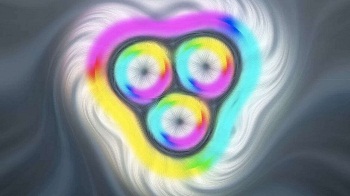There are ghostly shapes hidden in magnetic fields.
They’re not made of stuff in the way a lightning bolt or a beam of light is. A lighting bolt carries a fairly defined group of electrons from the sky all the way to the ground. Sunshine that hits your face consists mostly of the same photons that traveled millions of miles from the sun.
But magnetic fields contain things called skyrmions that are different from electrons and photons; a skyrmion is a knot of magnetic field lines looping around each other. As it drifts from one spot to the next,
a skyrmion makes itself anew out of the magnetic field lines that are already there. The knot holds together because magnetic field lines resist passing through one another. So, while skyrmions are insubstantial and different from objects we’re used to thinking about, they act like more tangible things.
Physicists call these skyrmions “quasiparticles,” and suspect they could explain phenomena as disparate as ball lightning and the nuclear structure of an atom. Now, in a new paper, researchers showed that skyrmions can be stuffed inside one another, taking on a completely new shape. These puffed-up “skyrmion bags” are fascinating objects in their own right, but the bizarre things might also be useful for futuristic computing, the researchers said.
Stuff ’em in a bag
The team revealed the skyrmion bags , The result relies on a key similarity between the ghostly quasiparticles and solid matter: the existence of antiparticles.
Just like protons have counterpart antiprotons that annihilate each other on contact with each other, skyrmions have antiskyrmions.
“An antiskyrmion is a skyrmion where all the numbers are reversed,” said researchers said of the new study.
So, if a magnetic field line points north in a skyrmion, it would point south in an antiskyrmion. But antiskyrmions and skyrmions powerfully repel one another. That turned out to be the key to building skyrmion bags, the researchers said.
“If we take a skyrmion and we stretch it out a bit and we take an antiskyrmion and place it in the center of it [the skyrmion] … they will not annihilate. It’s a stable construction,” Foster told Live Science.
What’s more, the researchers realized, once a skyrmion has been stretched, you can stuff even more antiskyrmions inside it.
How bags could solve the problem.
Put a bunch of skyrmion bags on a racetrack device, the researchers in the new study wrote, and a computer could encode and retrieve data based on the number of antiskyrmions in each bag that pass under the reader.
Where conventional computer storage relies on only 1s and 0s, a skyrmion bag system could use 0s, 1s, 2s, 3s and so on. That would open the door to much more complex forms of data encoding that could stuff far more information into a given space than a traditional binary method can.
Lara Khouli

